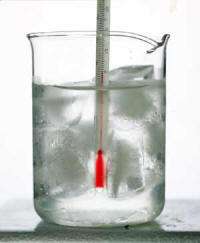SPPS traces atoms from solid to liquid

When a snowball melts, you can tell it has achieved a liquid state when the frigid water drips through your fingers. But if you could follow the melting process, driven by the heat of your hand, from its very first moments – the first trillionth of second, would you be able to point to the exact moment the snowflake crystals disorder into liquid H2O?
That’s the challenge facing researchers using the Sub-Picosecond Pulse Source (SPPS) to probe the activities of materials on ultrafast timescales. SPPS makes intense x-ray pulses lasting quadrillionths of a second (femtoseconds), enabling researchers to directly monitor the earliest atomic changes during melting with ultrafast x-ray diffraction.
In one of the first SPPS experiments, SLAC scientists looked at the laser-driven melting of a semiconductor material similar to silicon. In that study, they found that the atoms in the tetrahedrally shaped crystal moved away from their crystal lattice positions, but retained the overall crystal shape in the first 500 femtoseconds (half a picosecond). New follow-on research has extended the time range and shown more: that the atoms move faster parallel to the chemical bonds than they do in the perpendicular direction, opposite of what models have so far predicted.
“Our measurements appear to be in contradiction with theory, but currently lack sufficient detail to propose an alternative,” said Kelly Gaffney (SSRL). This work was led locally by Kelly Gaffney, Aaron Lindenberg, and Jerry Hastings of SSRL and critically depended on the efforts of the SPPS international collaboration. They think the results will be applicable to silicon and gallium arsenide semiconductors (a key material for lasing and producing polarized electrons).
When the laser light strikes the semiconductor crystal, it first disrupts the electrons in the crystal, allowing the atoms to break free from their bonds and move freely with their inertial energy, even before the energy from the laser increases the kinetic energy (velocity) of the atoms.
In those first 500 femtoseconds, the atoms start moving away from their initial positions, spreading out into a larger volume like ripples from a stone tossed into a puddle. At about 500 femtoseconds, the atoms have moved far enough to bump into their neighbors. The collisions produce random, diffusive motion, no longer preserving the tetrahedral shape.
“It may be the onset of moving like a liquid. It’s the first indication that it has properties distinct from a crystal, and it takes that long to happen,” Gaffney said.
The data suggests that collisions between atoms are the mechanism for turning a solid into a liquid. Until the atoms hit each other and lose memory of their velocity prior to colliding with one another, the atoms can’t be disordered as in a liquid.
The study also shows that direction matters. By exciting the crystal’s atoms, the laser has essentially changing the topography of the surface that the atoms glide on from a deep valley to a shallow dell. The atoms can go further before hitting boundaries (other atoms), although that distance depends on which direction an atom goes: a hockey player skating from center ice toward the goal travels farther before hitting the boards than a skater heading to the penalty box.
So the crystal disorders at different rates in different directions (a property called anisotropy), just as proposed by various models of electronically driven melting. However, the models have their direction backward from the observations. SPPS revealed that the atoms move farther in parallel to their bonds, rather than orthogonally to them.
Source: Stanford Linear Accelerator Center (by Heather Rock Woods)















